Matt Workman has produced a brilliant video where he does a detailed analysis of the lighting techniques used in Quentin Tarantino’s Hateful Eight movie. Matt Workman is a cinematographer and the founder of the website Cinematography Database. I tried to recreate two of the scenes using the lighting techniques he describes.
In analysing the exterior snow landscape scene where a stagecoach comes pounding through the snow, Matt speaks about how frustrating it can be when you film a scene and end up with a lot of white that blows out the background. He then suggests that with a large white background, it can be seen as an opportunity in post to do colour corrections and create a colour tone for the movie. For this particular scene, the colour values were dropped and a blue-grey colour tone created.
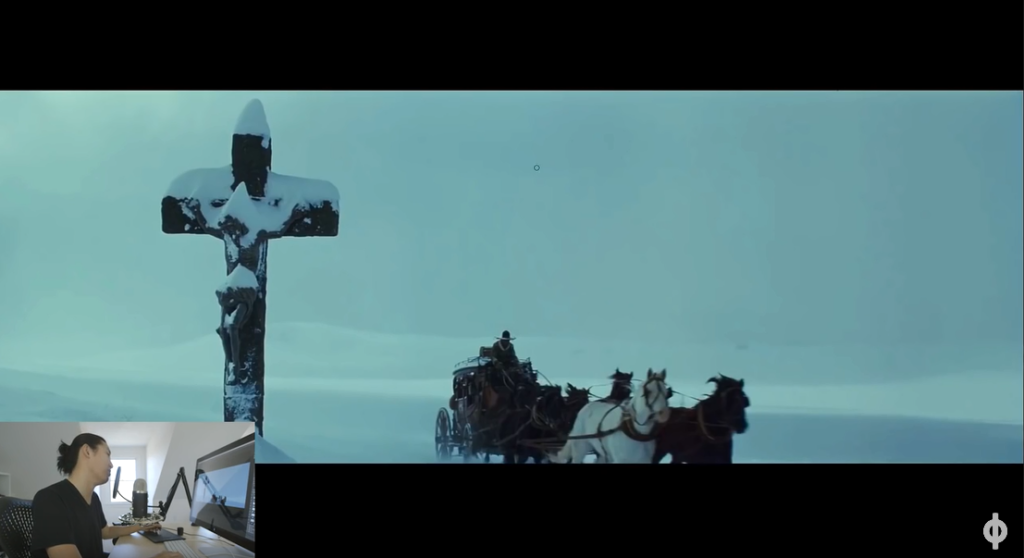
This colour is used extensively throughout the movie and is repeated even in the close up scenes, such as the one below.
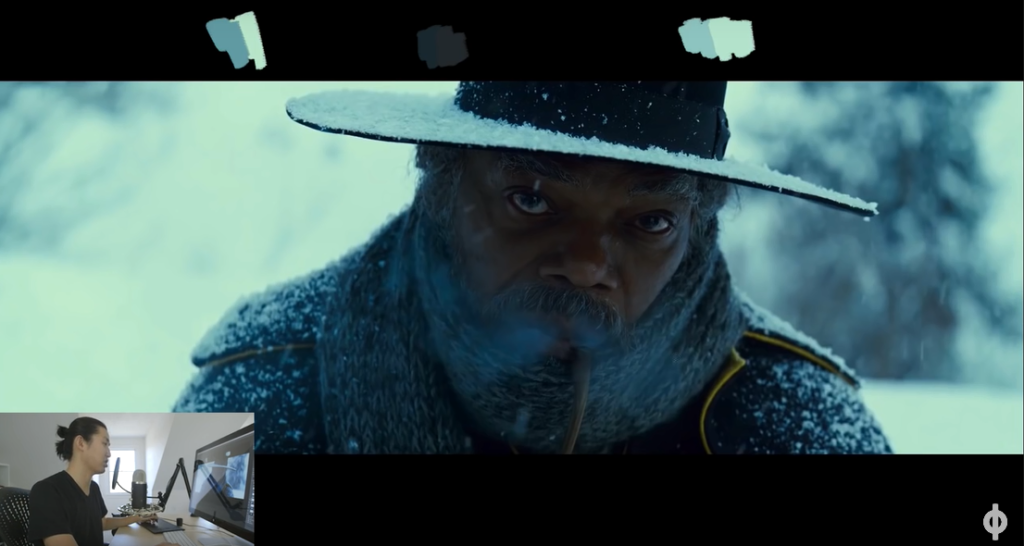
There is a subtle point made that with silhouettes, even small ones in the distance – the human brain can process what is being seen and work out a lot of information. It is often possible to tell from a small silhouette the age and sex of a person and possibly also their state of health (i.e. if they are injured) or whether they are wealth or poor, etc.
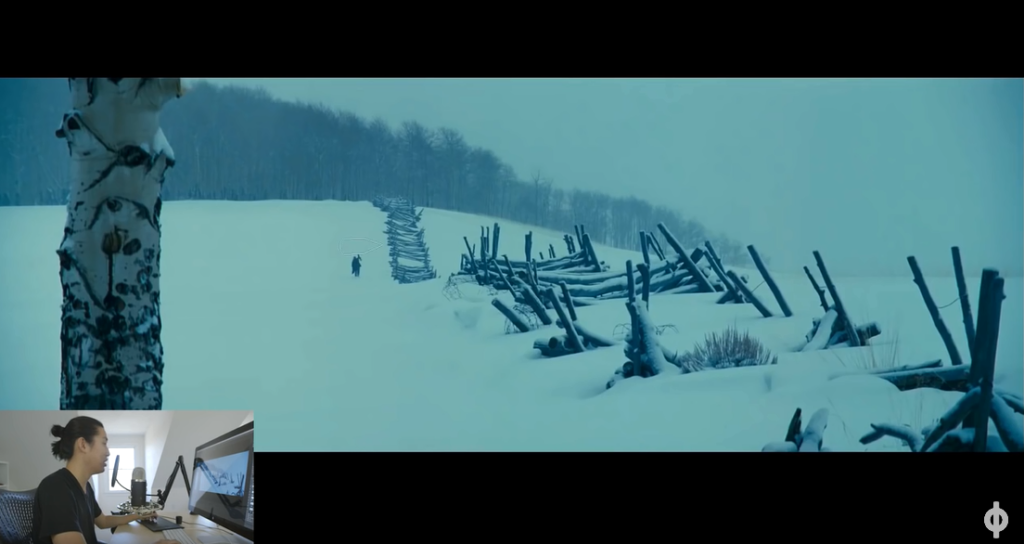
For this scene below, Matt points out that even with low cost films that have limited lighting equipment, it is possible create effective shots using creative techniques such as this one. In the scene, completely natural lighting is used to backlight the characters in the barn. The barn door creates the framing provides the of the composition. He explains that for this type of shot, there is no need to balance the exposure between the interior to an exterior, but rather to expose for the lighted scene outside. The silhouettes must be defined enough to work out what they are and this can be done by allowing some of the silhouette to protrude into the white frame. The silhouette must hold together in the dark as well and a judgement call needs to be made as to whether some edge lighting is needed or not to light the character.
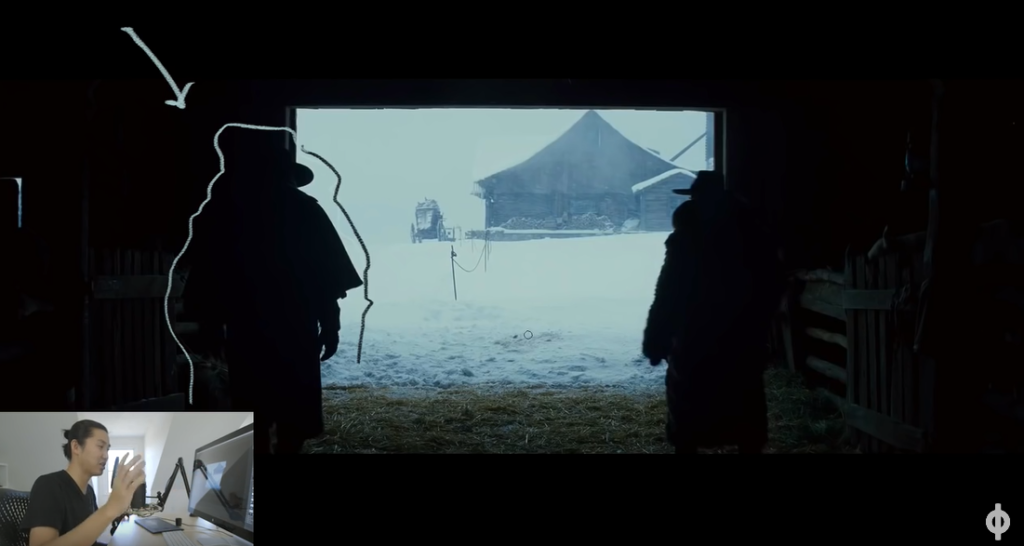
I decided to try to recreate this scene using the technique explained. Of course, I didn’t have a wonderful snowy landscape, but with a bit of improvising I could test out the technique in our house. The result is below. It is a fairly simple shot and exposing for the outside naturally drops the interior lighting and creates the silhouettes. Reflecting on the recreation afterward, I believe that I achieved the silhouettes ‘holding together’ even though I didn’t use any lighting except the natural lighting from the outside and small amount of light coming from behind me (glass door). I was very happy to have achieved this shot with so little effort.
As an active cinematographer, Matt speaks at length about how essential it is to learn the language of the live camera operating environment and working within a crew. He gives examples of what types of instructions may come from the Director of Photography (DoP) who may be monitoring 20 camera at the same time. These include timings to start the movement in the shot and the type of movement; panning, tilting, zooming, etc. In the image below, the DoP (Rob Richardson) is on the crane passing instructions to the crew so that he can get the opening shot of the stagecoach pounding through the snow. The shot started as a close-up of the cross (in the picture) and then the crane pulled back and the camera zooms out to a very wide shot that will take in the stagecoach in the distance approaching the audience.
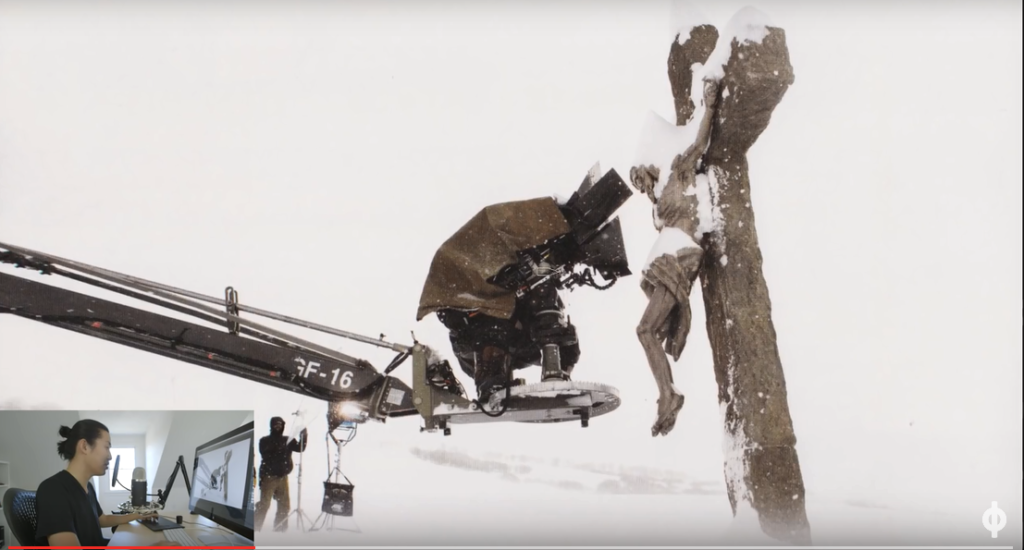
The second part of this video takes a detailed look at the use of lighting in various scenes. In one of the exterior scenes, a bounce lighting configuration was used, where the type of spot light equipment casts a wide throw backwards away from what is being filmed and is then bounded back into the scene from a huge silk screen. In the image below you can see all of this, the light shining backwards, the large screen that it is bouncing off and the actor that is being lit by the bounced light.
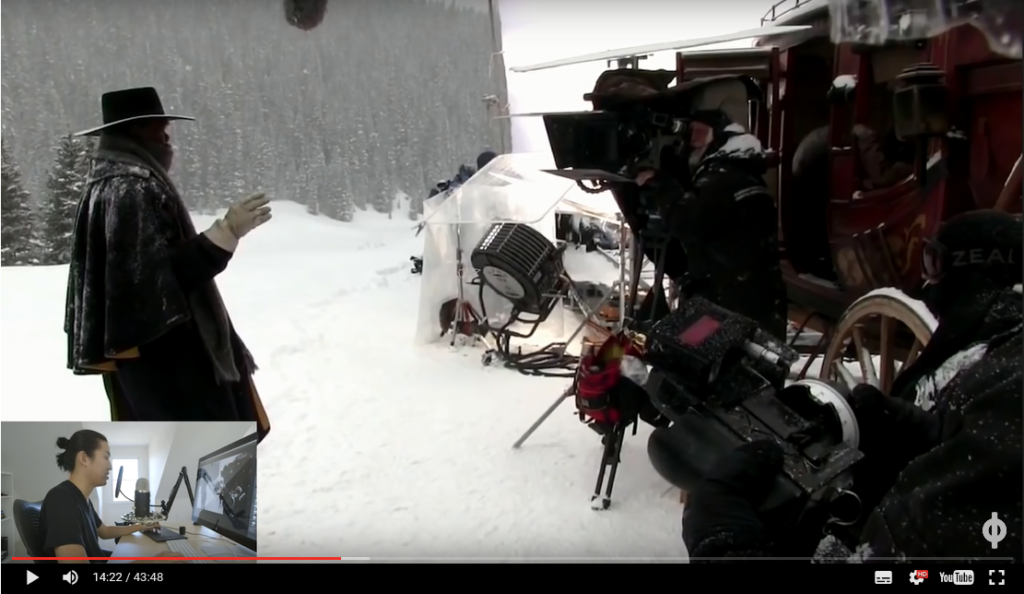
A technique called hot backlight and low bounce (or low effort) is used extensively for interior scenes in the Hateful Eight. In this scene the backlight camera is placed high above the scene, giving edge lighting the characters hat, back of his coat, sides of the piano and, more importantly, the piano keys. It is the lighting from the piano keys that then bounces onto the characters face and lights it. In tis first image you see the scene.
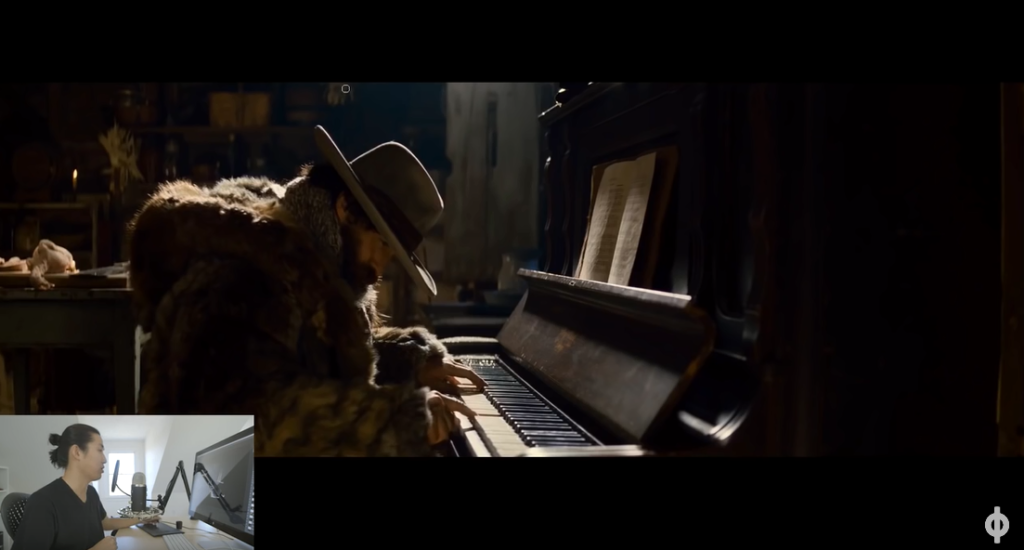
In the second image you see approximately where the backlight has been place and the directing of the bouncing light.
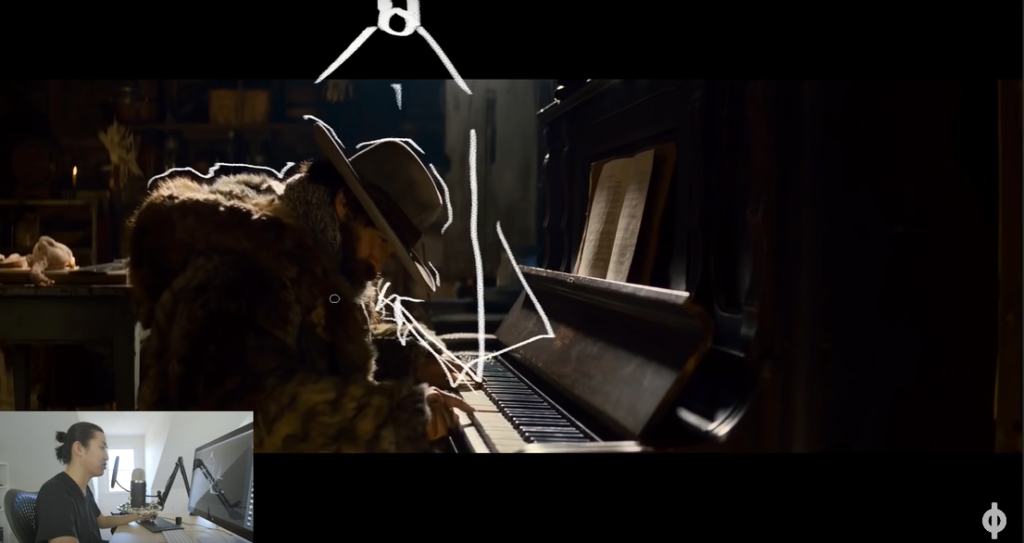
In the second example (below), there is again high backlighting, with light bouncing this time off the table in front of the actor to up light his face. What’s interesting is that in these scenes the tables are usually wooden tables and I’m not sure that the wood bounces light very well so I wondered if for this scene the ‘table’ may be of a more reflective material and then when there is a shot where the table needs to be scene it is switched back to a wooden table.
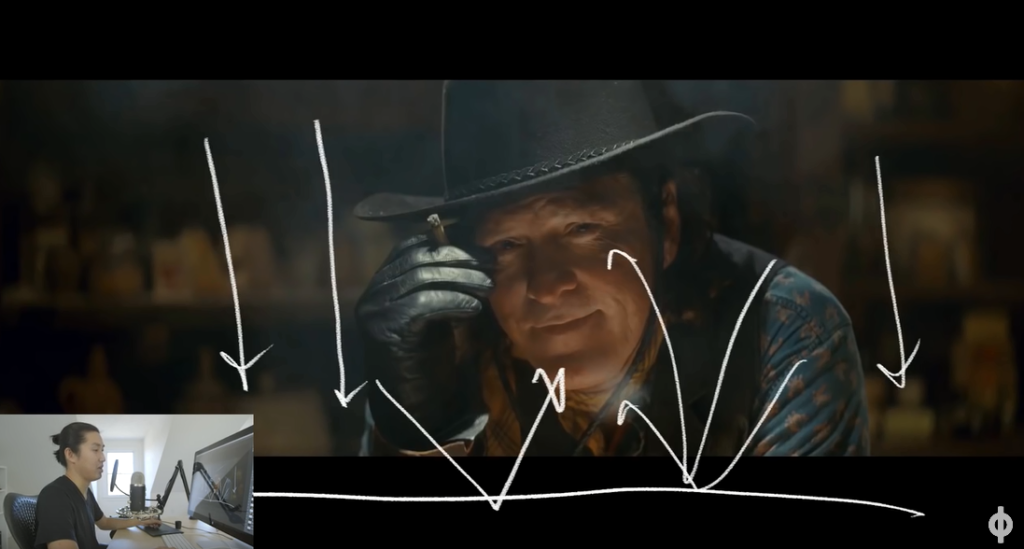
I was so intrigued by this bounced light techniques that I tried to replicate it. This was much more difficult to do by comparison to the silhouette shot. The major difficulty is working out where to position the backlit so that it provides the necessary reflections off the character’s hat and shoulders but at the same time reflects enough light off the table to light the face. At first I used a wooden table and, much as I suspected from the Hateful Eight table shot, the bounce wasn’t brilliant. I then put a white table cloth (well, actually it was a sheet) on the table and this created more bounce. Once I have figured out where to put the light, I was amazed at how much bounce there is off the table – the backlight is completely behind the subject so all the face lighting is bounce.
I also needed to spend quite a bit of time adjusting the exposure to get the correct effect. In practice I ended up filming this twice because during the first attempt there was too much light coming from outside that I could not control. The second thing I learnt from the day time exercise is the dangers of filming with windows in the background because the window was reflecting me, the camera and at times the backlighting – very useful lesson as the reflections are not always easily visible on the small camera viewing panel and only become obvious when seeing it on a much bigger monitor. AND, I know it’s not a cowboy hat, it’s the best I could find!
In the image below, the colour of the light is used effectively. The interior lighting, which is primarily from spotlights in the ceiling creating small hotspots over the set and creates a warm orange/yellow light. Whereas the windows and the door are lit with cold blue lights. Clearly this is meant to convey that it is cold and hostile outside and presumably, warm and inviting inside. In this scene, I did wonder about the motivation for the lighting – the ceiling spotlights that create the hotspots on the floor do not seem to have an obvious source; probably they could be understood as ceiling lights, but then it looks a bit unrealistic. In a scene like this, the main sources of light would be from the fire place and some visible room lighting. Possibly the way the scene is lit breaks the rules for light being motivated but nonetheless creates the atmosphere that the director is after.
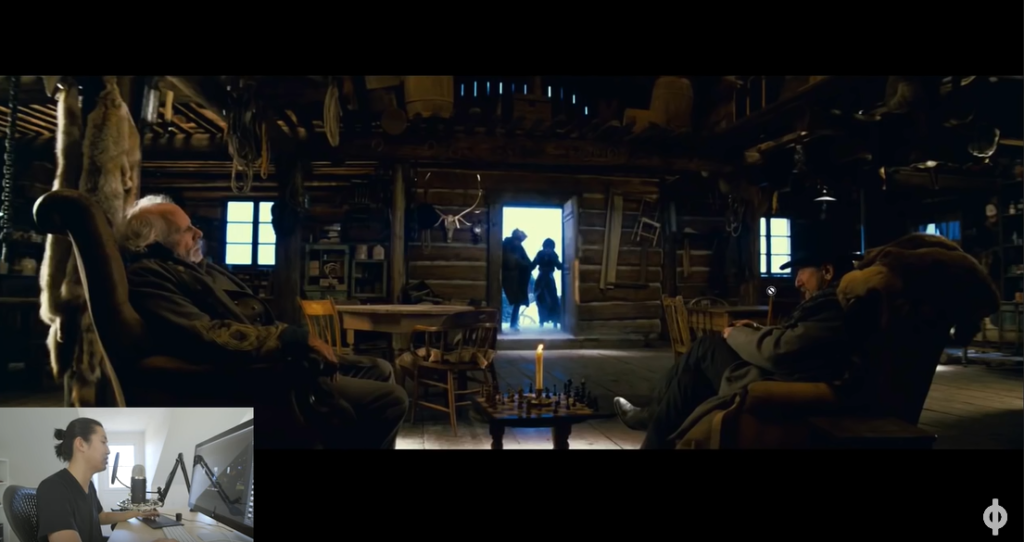
In this rather intriguing shot below, there is a window to the left of the frame with light pouring in and lighting the beard of the character on the right. This in turn is bouncing off his beard and lighting the face of the character on the left. A very bizarre but effect way to manage the light.
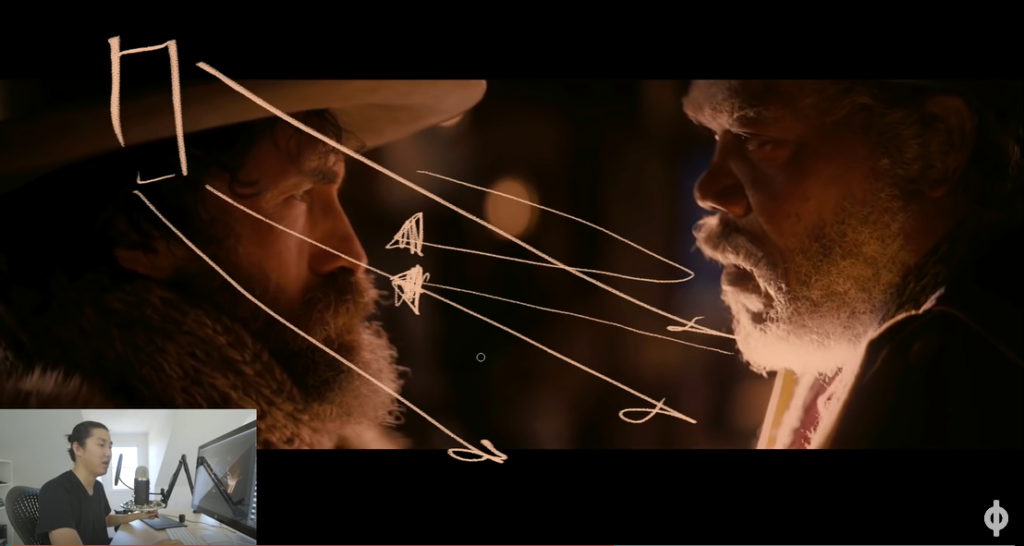
Matt spoke about how in older movies tungsten lighting was commonly used because that is what was available and because it gave skin tones a more natural look. Consequently, this is what an older generation has become accustomed to and regards are ‘normal’. For a younger generation, they have become far more used to florescent lighting (in shops, houses, etc.) and LED lights, so sets lit by tungsten will probably look a bit old fashioned, and could become a techniques for creating a particular mood/setting in the future. A further point was raised that tungsten lighting is now considered environmental unfriendly and therefore it’s use is slowly being restricted. He wondered if tungsten is on the way out and in the future it will become more difficult to make movies with tungsten lighting.
Sources:
The Cinematography of the Hateful Eight. Creat. Matt Workman. 11/04/2016. 43min 48s.
http://nofilmschool.com/2016/04/beards-bounce-cards-cool-lighting-tricks-hateful-eight
